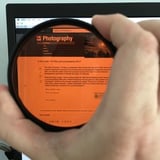Is the Cokin 173 filter just a backwards CPL?
No. The effect is similar to mounting your polarizer backwards, but much more pronounced on the Varicolor filter.
Here is what my Hoya HD CPL looks like at 0° and 90° polarization angles, when oriented for correct mounting (male threads towards camera):
- Note that this is NOT a variable-ND filter. In the right image, the filter blacks out the light because the light source itself is polarized (coming from an LCD, which uses polarization to control light output).


Hoya circular polarizer, normal orientation, at 0° (left) and 90° (right) polarization
When I turn the polarizer backwards, here's what it looks like, again at 0° and 90° polarization angles.
- Note that my iPhone's auto-white balance tried to adjust for the color shift in both images. The left, bluish-cast of the polarizer is actually more pronounced than shown. You can see the yellow-shifted LCD monitor outside of the CPL. The left image should actually have a cooler color-temperature. Similarly, the yellow-ish cast of the right image should be warmed up slightly (the monitor is slightly bluer than normal outside of the CPL view).


Hoya circular polarizer, reverse-mount orientation, at 0° (left) and 90° (right) polarization
I don't own the Cokin Varicolor, but I have Singh-Ray's Gold-N-Blue polarizer (same effect). Here's the Gold-N-Blue filter at 0° and 90°, oriented for correct mounting:


Singh-Ray Gold-N-Blue polarizer, normal orientation, at 0° (left) and 90° (right) polarization
Here's the Gold-N-Blue oriented for reverse-mounting:


Singh-Ray Gold-N-Blue polarizer, reverse-mount orientation, at 0° (left) and 90° (right) polarization
I couldn't tell a difference between the obverse- and reverse-mounted Singh-Ray Gold-N-Blue filter. But the degree of the effect between the the Gold-N-Blue and a reverse-mounted CPL is significant.
- Also note, that in real life, the effect of the Gold-N-Blue (and Varicolor, I presume) is not so pronounced to turn the world into Denver Broncos colors, or to make it look like a Michel Bay color-graded film. The blue and gold/orange is extremely saturated here because the color-separated light from the LCD is already polarized (by definition of being an LCD monitor).









